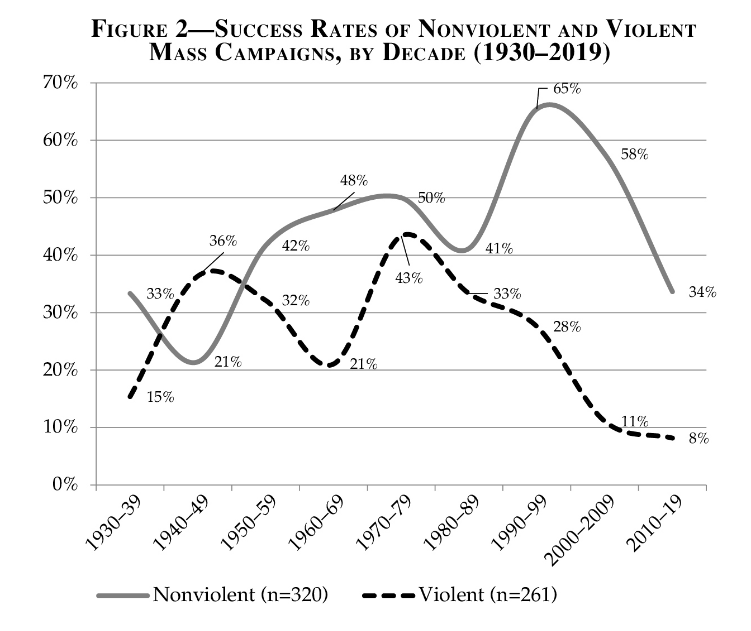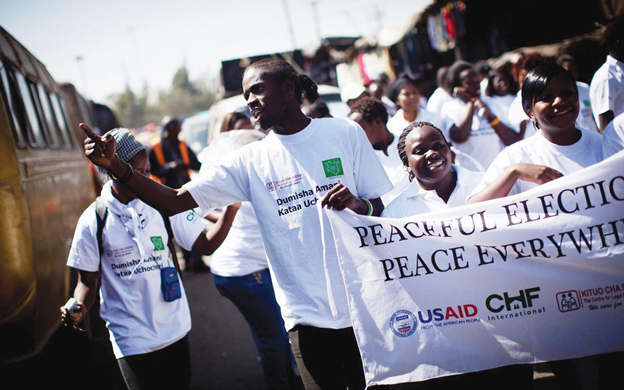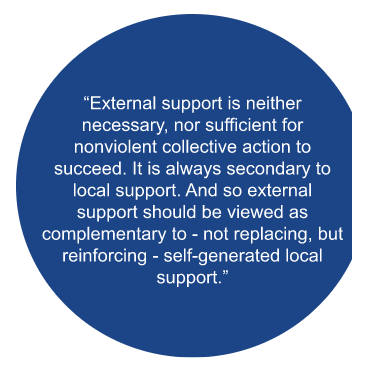|
What is Nonviolent Collective Action?
Over the course of the 20th century, nonviolent collective action became a powerful political force around the globe. From South Africa, to India, the Philippines, Ukraine, Georgia, Chile, and the United States, democratic freedoms expanded thanks to nonviolent collective action. Today, people around the world are participating in civic life through social movements, grassroots organizing, and other forms of nonviolent collective action more so than ever before in recorded history. And the effects of nonviolent collective action reverberate from Tunisia to Hong Kong, and from Bolivia to Sudan. It is a critical tool in combating authoritarianism because it leverages people power to expand inclusive governance and protect human rights.
Nonviolent collective action is an extra-institutional technique of sustained political, social, psychological, and/or economic action for building power and using it without the threat or use of violence. It is extra-institutional in that it operates primarily outside of formal political processes such as elections and lobbying. And it is nonviolent in that its main modus operandi rejects the threat or use of violence.
Nonviolent collective action is not passive, and it is not pacifism. It is active. It often involves communities that have been historically excluded from power, building political power in their society and using that power to change policy, hearts, and minds. In some contexts this involves grassroots organizing at the local level. In other contexts it involves creating a social movement at the national level. Nonviolent collective action is interchangeably referred to as civil resistance, nonviolent resistance, strategic nonviolent conflict, and nonviolent direct action. At its core, the story of nonviolent collective action is a story about extra-institutional, people-powered democratic processes.
Key Trends and Data
Nonviolent collective action isn’t just being used in every corner of the world. It is being used more often than ever before. From 2010-2019, there were nearly 100 new nonviolent campaigns seeking the hardest-to-win goals: expelling a foreign military occupation or colonial power, removing an incumbent national government from power, or creating territorial independence through secession. That is a 50 percent increase over the previous decade. Many more nonviolent campaigns sought to achieve policy reforms in their own countries. Whether for maximalist or reformist ends, people all over the world have been increasingly relying on nonviolent collective action as a way of demanding self-determination, human rights, social justice, and democracy.
Nonviolent collective action is a critical tactic to enhance democracy not only because of how often it is used. In every decade since the 1950s, nonviolent collective action has been more effective than violence at achieving these hardest-to-win goals. In fact, in the most recent decade, nonviolent collective action was four times as effective as violence.
 Source: Erica Chenoweth, “The Future of Nonviolent Resistance,” Journal of Democracy 31:3 (July 2020).
Despite this impressive success rate relative to violence, winning is not easy. Repression is almost certain, and success rarely occurs in a linear fashion. From 2010-2019, nonviolent campaigns succeeded only 34 percent of the time. This is a stark decrease from the 1990s when maximalist nonviolent campaigns were almost twice as likely to succeed. While some governments have learned to anticipate and repress nonviolent collective action, this decreased success rate likely has a lot to do with the changing nature of how people are using nonviolent action. People are increasingly reliant on mass protest and social media at the expense of long-term strategizing, organizing and coalition-building, and leadership development — things that build lasting political power. This shows in the data: despite some notably large movements, the average number of participants at the peak of a movement’s activity is half what it was two decades ago.
This month’s DRG Learning Digest focuses on nonviolent collective action, what it is, why it works, and how outsiders can support it.
-
Why Nonviolent Collective Action Works: Why nonviolent collective action helps democracies develop and remain resilient, and how nonviolent collective action is meeting the challenge of authoritarianism.
-
External Support for Nonviolent Collective Action: Three main modalities of external support and why such support should not replace, but rather reinforce, self-generated local support.
-
In Practice: DRG Support for Nonviolent Collective Action: Some examples of how DRG activities are currently supporting nonviolent collective action.
The Case for Nonviolent Collective Action
Why Nonviolent Collective Action Works
In their award-winning book, Why Civil Resistance Works, political scientists Erica Chenoweth and Maria Stephan describe the two main reasons why nonviolent collective action campaigns are more successful than violent ones. The first is that nonviolent campaigns have higher levels of participation. This is in part because a larger repertoire exists of low-risk nonviolent than violent actions. Also, deciding to participate in nonviolent collective action such as boycotting a business is less complicated morally than learning to use a weapon and actually using it. This relative ease of participating in nonviolent collective action can increase the diversity of participants. Women, youth, and the elderly often participate in nonviolent collective action.
This participation advantage and increased diversity of participants leads to the second major factor in the success of nonviolent collective action campaigns: a range of strategic and tactical advantages. It is riskier for a regime to repress violently a nonviolent campaign that represents a larger, diverse population than it is to quash a minority violently. Nonviolent collective action campaigns that represent a broad swath of society are also likely to have greater and stronger social ties to officials in the government. Those ties can increase and improve the knowledge that the opposition has of how a regime operates. Those social ties also increase the likelihood that the opposition can encourage at least a hands-off approach or even defections from the government. And finally a more diverse opposition increases the potential diversity of tactics available to campaign participants, employing various high or low risk options as appropriate for the context. This facilitates the campaign’s ability to adapt to changing dynamics.
Other critical features of successful nonviolent collective action efforts include unity of purpose, disciplined adherence to nonviolent tactics, and long-term strategic planning. Unsurprisingly, however, diverse participation can also present challenges that must be overcome in order to achieve these features and sustain the movement.
 A group of Kenyan youth march for peace before the general elections in March 2013. (Photo: USAID/Kenya)
How Nonviolent Collective Action Helps Democracies Develop and Remain Resilient
The effects of nonviolent collection action extend beyond the success or failure of the campaign. Chenoweth and Stephan found that from 1900 to 2006, a given country was eight times more likely to be democratic five years after a successful nonviolent campaign than after a successful violent campaign. In addition, countries where people undertook nonviolent collective action were 15 percent less likely to relapse into civil war. Additional scholarship reinforces the point that political transitions from non-democratic regimes that are driven by nonviolent collective action are more likely to result in democracy than political transitions driven by violent coups or other means.
Yet, nonviolent collective action’s greatest power is arguably not solely its ability to achieve policy reform or changes in governance. Instead, it is the ability to shift the “Overton window” in a society, i.e. fundamentally changing the range of policies and practices that are politically acceptable to the population and to status quo-oriented leaders. Nonviolent collective action expands people’s imagination about what is politically possible in their society.
Sociologist Donatella della Porta describes how nonviolent collective action has ushered in powerful alternative politics in a number of societies. These democratic innovations from below related to participatory and deliberative practices include “crowd-sourced constitutions,” referendums from below, and political parties built on movement work. Nonviolent collective action has also been used successfully to help curtail corruption on multiple continents. These achievements are two additional ways that nonviolent collective action has helped democracies develop and remain resilient.
How Nonviolent Collective Action is Meeting the Challenge of Authoritarianism
For over 16 years, rising authoritarianism has led to shrinking civic space for formal civil society organizations. Because social movements, grassroots organizing, and other forms of nonviolent collective action do not necessarily rely on formal civil society organizations, people around the world have been gravitating to them as a way of defending and promoting democracy, social justice, and human rights. For example, people around the world are innovating in the digital sphere in response to authoritarianism. And they’re connecting and learning from each other across borders to defend and strengthen civic space and overcome restrictions to fundamental freedoms of assembly, association, and expression. Yet, the balance of power between activists and authoritarians is constantly evolving, a dynamic situation in which either side can deny the other what they want, and it remains to be seen which side prevails.
External Support for Nonviolent Collective Action
U.S. Institute of Peace (USIP) research suggests that external support for civic engagement through informal organizations, including social movements engaged in nonviolent collective action, requires a different mindset than support for civic engagement through formal civil society organizations. The most helpful external support is flexible and responsive to the needs of movements and organizers. External support should not divert their attention away from the critical work of organizing and building legitimacy in their own communities and toward fulfilling funding proposals and reporting requirements of donors thousands of miles away. According to one anonymous donor, it is imperative for donors to “follow the movements.”
|
Movements win primarily because of what they do within their borders, not because of the support they get from outside their borders. External support is neither necessary nor sufficient for nonviolent collective action to succeed. It is always secondary to local support. External support should be viewed as complementary to — not replacing, but reinforcing — self-generated local support. In this vein, external donors should ensure that their actions abide by the basic principle, “Do No Harm.”
There are three main modalities of external support for nonviolent collective action:
|
|
 |
- The first is support for expanding and protecting online and offline civic space. This includes support for human rights defenders, independent media, and advocacy and diplomatic efforts to protect freedom of speech and assembly.
- The second is indirect support for nonviolent collective action via activist-advised multi-donor pooled funds, and trusted non-profit intermediaries or re-granters.
- The third is direct support via fellowships, funding, technical assistance, training, and in-kind support such as IT equipment and office space.
Research suggests that support for activist leaders to convene, develop relationships, and receive training that strengthens local leadership, organizing capacity, movement strategy, and resiliency may be particularly helpful for the success of nonviolent collective action. Organizers repeatedly ask donors to coordinate their grantmaking to offer complementary support and to avoid countervailing support or competition among grantees.
Finally, donors develop stronger relationships with organizers and activists when they practice an ethics of listening and learning, and explicitly acknowledge power dynamics in those relationships. Donors have some of the most effective partnerships with organizers and activists when they practice trust with, instead of control over, these local partners.
In Practice: Examples of Current DRG Support for Nonviolent Collective Action
Innovation for Change (I4C) is a global, community-led network of 27,000 participants in 143 countries: people and organizations committed to defending and strengthening civic space and to overcoming restrictions to fundamental freedoms of assembly, association, and expression. USAID and its donor partners have supported I4C’s seven regional hubs around the world that serve as platforms for organizers, activists, and formal civil society organizations to connect, partner, learn, and innovate together. Hubs are located in Latin America and the Caribbean, the Middle East and North Africa, Sub-Saharan Africa, Central Asia, South Asia, East Asia, and the Pacific; each hub operates independently and has developed particular areas of expertise. For example, the Middle East and North Africa Hub has focused on digital rights and security, and has shared this expertise with other hubs.
In the Republic of Georgia, local and regional online media and broadcasters increasingly play a role in mobilizing citizens around community needs and problems. IREX’s assistance to regional media, supported by USAID, has shown that, “citizens often give leads to local media outlets that, in turn, advocate for change by making social justice issues visible at a larger scale and promoting accountability for local governments.” Tapping into comparatively high levels of civic participation in the Republic of Georgia, USAID also strengthens grassroots civil society organizations, enabling them to effect meaningful change on global issues such as air quality and climate change. For example, advocacy by local environmental group Gavigudet (whose name means, “We are suffocating”) against the air pollution caused by a local industrial zone resulted in changes to national legislation, and civic actions and rallies to ensure that the legal changes are implemented, despite repeated physical and verbal threats.
Additional Resources: External Support for Nonviolent Collective Action
Use Our Resources!
Welcome to the DRG Learning Digest, a newsletter to keep you informed of the latest learning, evaluation, and research in the Democracy, Human Rights, and Governance (DRG) sector. Views expressed in the external (non-USAID) publications linked in this Digest do not necessarily represent the views of the United States Agency for International Development or the United States Government.
Don't forget to check out our DRG Learning Menu of Services! (Link only accessible to USAID personnel.) The Menu provides information on the learning products and services the Evidence and Learning Team offers to help you fulfill your DRG learning needs. We want to help you adopt learning approaches that emphasize best fit and quality.
The Evidence and Learning Team is also excited to share our DRG Learning, Evidence, and Analysis Platform (LEAP) with you. This Platform contains inventories of programmatic approaches and indicators, evidence gap maps, and data portraits—all of which can be very useful in DRG activity design, implementation, evaluation, and adaptation. Some of these resources are still being built, so check back frequently to see what has been newly added.
We also want to share our DRG Learning Harvest with you! (Link only accessible to USAID personnel.) This is a searchable database of DRG learning products, including summaries of key findings and recommendations, drop-down menus to easily find documents related to a particular country or program area, and links to the full reports on the DEC.
Our friends at the Varieties of Democracy (V-Dem) Institute are also seeking to expand their research partnership with USAID on the complex nature of democracy by inviting research questions from you for V-Dem to work on. If there's a DRG technical question you've been wondering about, please email the Evidence and Learning Team at ddi.drg.elmaillist@usaid.gov.
We welcome your feedback on this newsletter and on our efforts to promote the accessibility, dissemination, and utilization of DRG evidence and research. Please visit the DRG Center's website for additional information or contact us at ddi.drg.elmaillist@usaid.gov.
|